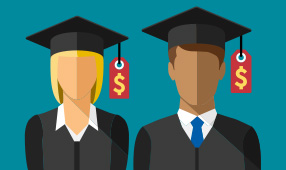Key takeaways
- Strategic savers have a game plan before thinking of ways to cut costs.
- It’s important to define your goals then establish a specific savings account for each objective.
Are you looking to save money—or become a strategic saver?
There’s a difference between the two. People who suddenly realize that they need to save money—whether for an appliance, a car or their retirement—are like crash dieters. They commit for a while, but then slip back into their old habits. Sure, they save a few dollars (or lose a few pounds) but they never incorporate a ‘bigger picture’ game plan that’s built to last.
In contrast, strategic savers start with the game plan before thinking of ways to cut costs. They begin with goals and then develop a realistic roadmap to drive toward them. In other words, they’re focused on something greater than collecting coupons and skipping those $4 Cinnamon Dolce Lattes from Starbucks. “Many of us don’t really stop to consider what is most important to us,” says Tana Gildea, a certified financial planner and author of “The Graduate’s Guide to Money.” “A values-based spending plan helps you determine what matters.”
Start by defining your goals
For example, do you want to establish an emergency fund, buy a house or plan a bucket-list vacation? Within each goal, assess what exactly would make you happy. “If it’s a house, do you care about size and location?” Gildea says. “Are you willing to become ‘house poor’ and sacrifice in other ways? Or are you just seeking to stop renting and put a roof over your head? Do you want to retire early, or are you fine with living for the ‘now’ and working longer? Are you eager to acquire ‘stuff,’ or are you more interested in experiences and the people you’re with?”
Next, establish a savings ‘bucket’ for every goal
Think in categories as opposed to a general slush fund. This means designating a specific savings account for each objective. This lends greater discipline to your mindset—your ‘emergency’ fund is for unexpected disasters only! It’s off-limits for anything else, such as dipping into it to pay for, say, an impromptu weekend vacation.
“Different accounts help when you’re making decisions about that ‘something new,’ ” Gildea says. “If you suddenly get the urge for a purchase which costs a couple hundred dollars or even $2,000, you’re forced to decide what else is going to get short-changed. Your kids’ college fund? Your future beach house? Your nest egg? When you’re faced with these choices, it’s easier to conclude that a new big screen TV isn’t as important as what you’ve been saving for.”
And you want to match the right savings/investment vehicle to each designated goal. Toward this end, the following guidelines were suggested by Danny Kofke, a retirement consultant and former elementary school teacher. Kofke is also the author of three personal finance books, including “How To Survive (and Perhaps Thrive) On A Teacher's Salary.”
- Emergency fund. This is arguably the most immediate and critical of savings objectives, because no one ever knows when a layoff or major illness/injury will come up. Depending upon your situation, experts advise consumers to have anywhere from three to nine months’ worth of living expenses set aside in a bank savings account. You won’t make much interest at today’s rates. But you won’t lose money either. “The purpose of an emergency fund isn’t making lots of interest,” Kofke says. “It’s to avoid paying interest if an emergency actually happens by living on available savings, as opposed to depending upon a credit card.”
- Home repairs. A savings account is best suited for this bucket as well, especially if the repair is required due to an unanticipated disaster. “For all intents and purposes,” Kofke says, “this is an emergency fund too. So you want enough in the account to cover this.”
- Major appliances. Given that appliances are a bit more predictable in terms of how long they’ll last, a bank certificate of deposit (CD) will work, assuming you can time the CD’s end date according to when you expect to replace the appliance. “If you bought it within the past five years, you should be fine for a while,” Kofke says. “You can use the time to earn interest that you wouldn’t otherwise with a savings account.”
- Car. Like appliances, you should have a sense of when you’ll need to get a new car. So a CD could work here, too.
- Vacation/travel. The 12-month CD is perfect, especially if you know you’re going to go somewhere a year in advance.
- College for children. States offer a wide variety of 529 plans which allow for you to put money aside for your kids’ college costs on a tax-deferred basis. They typically make available a variety of investment choices, ranging from aggressive to conservative. “You want to diversify, but not be so heavily invested in stocks when your child is closer to graduating from high school,” Kofke says. “You have to protect yourself if the market takes a downturn right when you need to pay for college.”
- Retirement. Again, a diversified mix of stocks, mutual funds and bonds applies—with an aggressive selection early on and then a more conservative one as you approach retirement age. “During the last economic crash, many folks were heavily invested in stocks and—when the market tanked—lost much of their retirement savings in terms of portfolio value,” Kofke says. “Which means they had to work years longer than they expected to before. A sound financial advisor will help you gain interest on your investments while reducing risk.”












